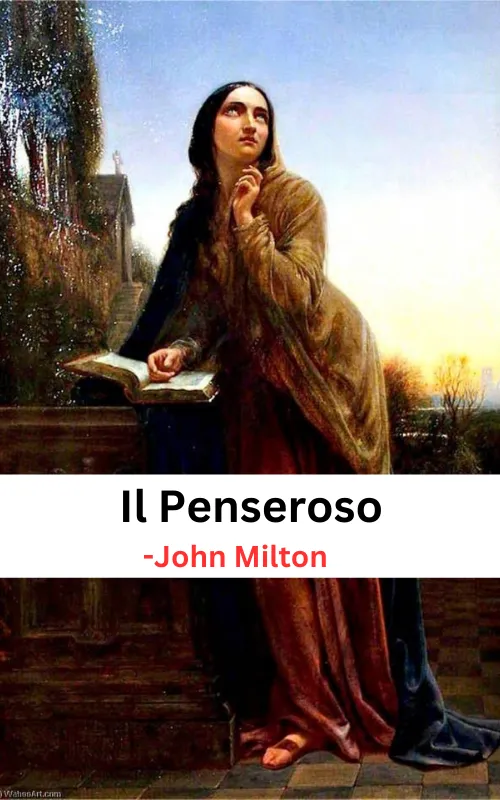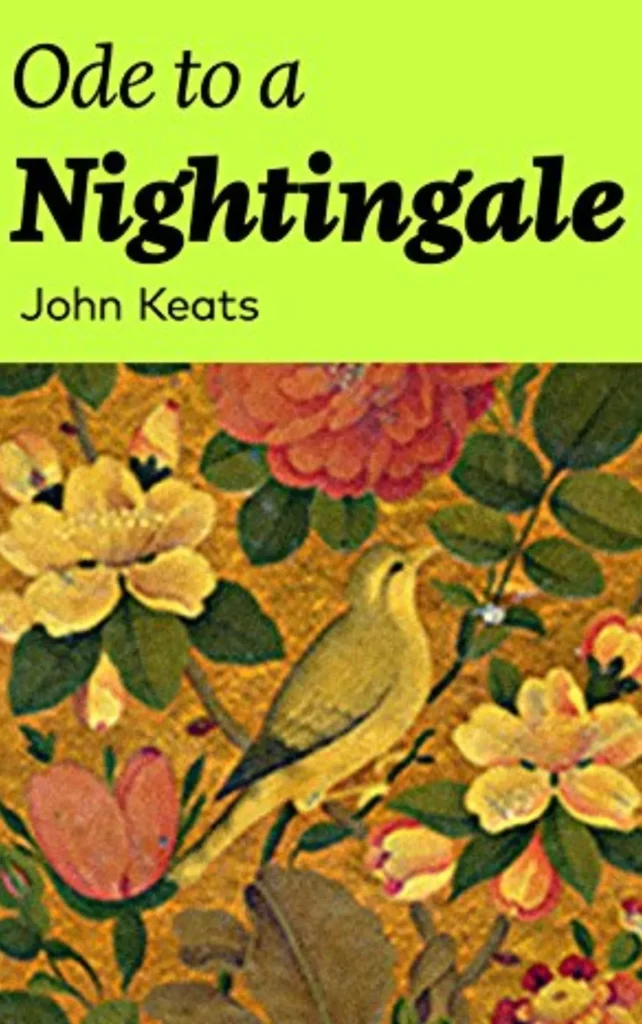About Poem: il Penseroso
| Title | Il Penseroso |
| Author | John Milton |
| Date of publication | 1645 |
| Genre | Pastoral, meditation |
| Tone | Reflective, introspective, and melancholic |
| Verse form | Rhymed octosyllabics |
| Setting | The poem is set in a rural landscape, featuring the beauty of the night, nature, and classical allusions |
| Speaker | The poet |
| Imagery | Moonlit landscapes, owls, books, contemplative solitude |
| Subject | The pleasures of a contemplative life |
| Setting | A variety of locations, including a rural landscape, a city, and a scholar’s study |
| Major themes | Melancholy, solitude, music, poetry, contemplation, the meditative life |
| Key symbols | The goddess Melancholy, the church bell, the organ, the nightingale, the moon, the stars, the scholar’s books and papers |
Themes: il Penseroso
The themes of “Il Penseroso” by John Milton are:
- Contemplation ➤ The poem focuses on the pleasures and virtues of a thoughtful and introspective life.
- Melancholy ➤ It delves into the beauty and richness of a melancholic, reflective state of mind.
- Solitude ➤ The poem celebrates the value of being alone and the intellectual and emotional benefits it can bring.
- Appreciation of Nature ➤ It describes the appreciation of nature, particularly the night and its tranquil beauty.
- Classical Allusions ➤ The poem references classical literature and philosophy, emphasizing the influence of ancient ideas on the contemplative life.
Literary Devices: il Penseroso
The literary devices of “Il Penseroso” by John Milton are:
- Alliteration ➤ The repetition of consonant sounds at the beginning of words, such as “shadowy, silent” or “moping melancholy.”
- Metaphor ➤ A figure of speech that compares two unlike things, often used to convey deeper meanings. For example, the poet compares the contemplative person to a “pensive nun” and uses the metaphor of the “midnight bell” to symbolize the passing of time.
- Personification ➤ Giving human qualities to non-human entities. In the poem, Night is personified as a “black-vested” figure, and Melancholy is described as sitting “in her dim museum.”
- Symbolism ➤ The use of symbols to represent ideas or qualities. The poem is filled with symbolic imagery, such as the “owl” representing wisdom and the “poppy” symbolizing sleep.
- Paradox ➤ The use of seemingly contradictory ideas that, when put together, reveal a deeper truth. The poet explores paradoxes in the contrast between the active and contemplative life.
- Imagery ➤ Vivid and descriptive language that appeals to the senses. Milton uses rich imagery to paint a picture of the scenes and emotions he wants to convey, like the “storied windows richly dight” or the “moonlit meadows.”
- Enjambment ➤ The continuation of a sentence without a pause beyond the end of a line, stanza, or couplet. This technique creates a flowing and natural rhythm in the poem.
Watch Full Poem Summary Video
il Penseroso- Summary & Analysis
Il Penseroso” is a pastoral poem written by John Milton, who is better known for his epic works like “Paradise Lost.” This poem, written as a companion piece to his more famous “L’Allegro,” explores the contrasting aspects of melancholy and joy in a contemplative and reflective manner. It consists of 82 lines divided into 15 stanzas, each of which offers a distinct glimpse into the poet’s thoughts and emotions.
Stanza 1
The poem begins with a reflection on the speaker’s preference for the quiet and serene life of “Il Penseroso,” which means “the thoughtful one.” This persona represents the more introspective and melancholic aspects of human nature. The speaker prefers “midnight” and the “owl” as their companions, embracing solitude and contemplation.
Stanza 2
The second stanza introduces the idea of a “pensive mood” that the speaker often finds themselves in. They choose to dwell in “Cloister’s pale” or the quiet, peaceful abode of a monastery. This is contrasted with the lively and bustling activities of the day.
Stanza 3
In this stanza, the poet presents the image of the “Moping Owl” and the “moping Hare” as symbolic of his own pensive nature. He is not interested in the cheerfulness of the morning, unlike the more vivacious persona of “L’Allegro.”
Stanza 4
The fourth stanza paints a picture of the poet walking in the “Starry Ploughed” fields at night. He draws inspiration from the “solemn Night” and the “musing Midnight.” The poet finds solace and inspiration in the darkness, and the stars above become his companions.
Stanza 5
Here, Milton describes the various literary and mythological sources of inspiration that fuel his melancholic nature. He mentions the “Storied windows” of churches and the “fairy Mab” who brings dreams. These sources of inspiration are contrasted with the lively music and dance of “L’Allegro.”
Stanza 6
In the sixth stanza, the poet alludes to various classical and mythological figures like “Plato” and “Sphinx.” He envisions himself studying in a “lonely Tow’r” surrounded by books and ancient manuscripts. These intellectual pursuits are a source of delight for the contemplative persona.
Stanza 7
Milton explores the joys of reading and intellectual pursuits in greater detail. The “Antick Pageantry” refers to the vivid and imaginative worlds presented in literature, providing an escape from the mundane. The poet revels in the “learned Sage’s” company and is transported to other realms through his reading.
Stanza 8
In this stanza, the speaker expresses a preference for the “sweet Birds” of night, like the nightingale, over those that sing during the day. He believes that the melodies of the night birds have a deeper, more profound impact on the soul, invoking a sense of melancholic pleasure.
Stanza 9
The ninth stanza continues to delve into the contemplative persona’s love for the night. The poet wishes to walk in the “dusky Grove” where the “Glow-worm” and “fire-fly” provide a soft, mystical illumination. This tranquil environment is more appealing than the bustling revelry of daytime.
Stanza 10
The poet describes the soothing sounds of the night, with the “whispering Wind” and the “nightly Murmur of a running Stream.” These natural sounds are a source of comfort and inspiration for the thoughtful soul. The poet expresses a desire to be “Rapt in Peace” within this serene setting.
Stanza 11
Milton contrasts his pensive nature with the joyful character of “L’Allegro.” He imagines the joyful persona in a “cheerful Sward” or green meadow, engaged in lively activities like dancing and singing. The two personas represent the opposing aspects of human temperament.
Stanza 12
The twelfth stanza presents a vision of the “weary’d Ox” returning from labor and the “Curfew” tolling, signaling the end of the day’s activities. The poet finds beauty in the peacefulness that descends as evening approaches, appreciating the quietude that follows the day’s toil.
Stanza 13
In this stanza, the poet reflects on the charms of moonlit nights when “Cynthia” (the Moon) shines brightly in the sky. This celestial scene is more appealing to the pensive soul than the “gladsome Blaze” of the noonday sun.
Stanza 14
Milton introduces the concept of “dreamy Night” in this stanza. He envisions himself as a dreamer who can explore the realms of imagination during the night. The “wizard’s Dreams” allow him to transcend the boundaries of reality and wander through the enchanting landscapes of his own mind.
Stanza 15
The poem concludes with a reflection on the pensive persona’s preference for the night’s solitude and contemplation. Milton believes that his thoughtful nature will lead him to virtue and wisdom. He looks forward to the “far-off divine event” that awaits him, signifying a hopeful and optimistic outlook.
FAQs: Il Penseroso
What is the meaning of Penseroso?
Penseroso is an Italian word that means “the thoughtful one” or “the thinker”. In Milton’s poem, it refers to the speaker’s love of solitude and contemplation.
Is Il Penseroso a pastoral poem?
Yes, Il Penseroso is a pastoral poem. It is a poem about the beauty of the natural world and the pleasures of a contemplative life.
What is the rhyme scheme of Il Penseroso?
The rhyme scheme of Il Penseroso is AABBCC.











